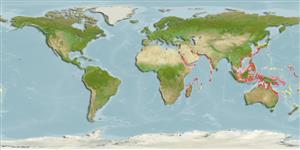Teleostei (teleosts) >
Callionymiformes (Dragonets) >
Callionymidae (Dragonets)
Etymology: Callionymus: Greek, kallion, comparative of kallos = beautiful + Greek, onyma = name; with a better name .
More on author: Regan.
Environment: milieu / climate zone / depth range / distribution range
Ecology
Marine; demersal; depth range 1 - 20 m (Ref. 4405). Tropical
Western Indian Ocean: southern Red Sea to the Cape of Good Hope, the Persian Gulf, and southwestern India (Ref. 9608, 4405).
Size / Weight / Age
Maturity: Lm ? range ? - ? cm
Max length : 13.0 cm TL male/unsexed; (Ref. 30573); common length : 10.0 cm TL male/unsexed; (Ref. 9608)
Dorsal spines (total): 4; Dorsal soft rays (total): 9; Anal spines: 0; Anal soft rays: 8. Color varies from yellow to dark brown; 1st dorsal fin of males light grey with dark lines, 1st and 4th spines longest; 1st dorsal fin of females black, 1st spine longest, 4th spine shortest (Ref. 4405).
Inhabits shallow sandy bottoms (Ref. 5213). Feeds on benthic crustaceans, worms and snails (Ref. 9608).
Life cycle and mating behavior
Maturities | Reproduction | Spawnings | Egg(s) | Fecundities | Larvae
Fricke, R., 1986. Callionymidae. p. 770-774. In M.M. Smith and P.C. Heemstra (eds.) Smiths' sea fishes. Springer-Verlag, Berlin. (Ref. 4405)
IUCN Red List Status (Ref. 130435)
Threat to humans
Harmless
Human uses
Fisheries: minor commercial
Tools
Special reports
Download XML
Internet sources
Estimates based on models
Preferred temperature (Ref.
123201): 23.7 - 29, mean 27.3 °C (based on 1120 cells).
Phylogenetic diversity index (Ref.
82804): PD
50 = 0.5000 [Uniqueness, from 0.5 = low to 2.0 = high].
Bayesian length-weight: a=0.00912 (0.00408 - 0.02036), b=2.77 (2.59 - 2.95), in cm total length, based on LWR estimates for this Genus-body shape (Ref.
93245).
Trophic level (Ref.
69278): 3.3 ±0.48 se; based on food items.
Resilience (Ref.
120179): High, minimum population doubling time less than 15 months (Preliminary K or Fecundity.).
Fishing Vulnerability (Ref.
59153): Low vulnerability (10 of 100).
